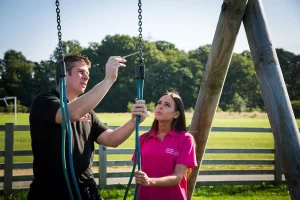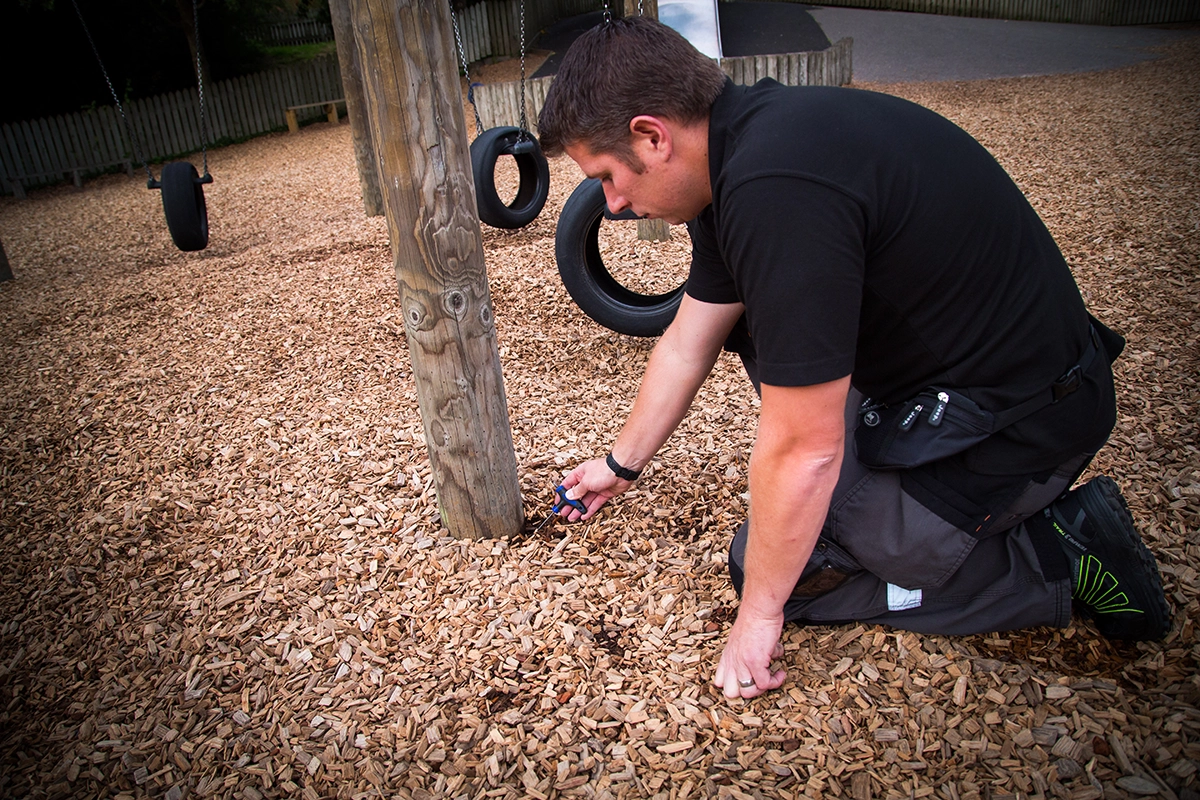Striking the Balance: Ensuring Safety in Playgrounds for Fun and Well-Being
Playgrounds are essential spaces for children’s growth and development, offering a haven of laughter, exploration, learning and social interaction. As we design and build these spaces, an ever-present question looms: How safe should playgrounds be? Striking the right balance between safety and the inherent risks of play is crucial to creating environments that foster not only physical health but also the emotional and social well-being of our children.
The Importance of Play in Child Development
Before delving into the safety aspect, let’s underline the significance of play in a child’s life. Play is not just a way for children to expend energy; it’s a fundamental component of their cognitive, emotional, and social development. Playgrounds provide a canvas for imagination, a stage for social interaction, and a gymnasium for physical activity.
 Safety Standards: A Necessity, Not an Option
Safety Standards: A Necessity, Not an Option
In recent years, safety standards for playgrounds (En 1176) have become more stringent, and for good reason. The goal is not to eliminate all risk—after all, some risk is inherent in any physical activity—but rather to mitigate hazards to a level where children can explore and play with minimal threat to their safety.
Understanding and adhering to these standards is essential for playground designers, manufacturers, and those responsible for maintaining these spaces. These guidelines encompass everything from the types of materials used to the spacing between equipment and the surfacing beneath. Compliance ensures that the risk of serious injury is significantly reduced.
Balancing Risk and Benefit
While safety standards provide a necessary framework, it’s equally crucial to recognise the value of allowing children to take risks during play. Risk-taking is an integral part of learning, building resilience, and developing problem-solving skills. Overly sanitised, risk-free environments may hinder a child’s ability to assess and navigate challenges in the real world.
Consider a playground slide—a common feature in most play areas. While ensuring that the slide is designed to prevent major injuries, a certain level of risk is involved. Slides teach children about gravity, spatial awareness, and the exhilaration of controlled descent. The challenge lies in offering these experiences without compromising safety.
Age-Appropriate Design: Catering to Developmental Stages
One key to ensuring safety in playgrounds is designing spaces that are age-appropriate. A toddler’s motor skills and risk tolerance differ significantly from those of a pre-teen. Separating play areas for different age groups allows for equipment and challenges tailored to the developmental stage of the children using them.
Additionally, signage and visual cues can guide parents and caregivers on the intended age group for specific areas. Clear communication helps in creating a shared responsibility for safety among those supervising the children.
 Surfacing Matters: The Role of Impact-Absorbing Materials
Surfacing Matters: The Role of Impact-Absorbing Materials
Playground surfaces play a critical role in mitigating injuries, especially in areas beneath climbing structures and swings where falls are more likely to occur. Materials like rubber mulch, wet pour, engineered wood fibre, and synthetic turf offer impact absorption, reducing the severity of injuries from falls.
Regular maintenance of these surfaces is essential to ensure they remain effective. Loose fill materials, for example, might need periodic replenishment to maintain their impact-absorbing properties.
Community Involvement: Ensuring Continued Safety
The responsibility for playground safety extends beyond designers and manufacturers to the communities that utilise these spaces. Regular inspections, reporting of damaged equipment, and adhering to posted guidelines are all essential aspects of maintaining a safe play environment.
Community involvement can also extend to creating awareness about the importance of supervision. While playgrounds are designed with safety in mind, the presence of responsible adults can significantly reduce the likelihood of accidents.
 Inclusive Design: Safety for All
Inclusive Design: Safety for All
Ensuring playground safety also means designing with inclusivity in mind. Children of all abilities should have the opportunity to play. Inclusive design goes beyond physical accessibility—it considers sensory elements, ensuring that children with different needs can engage with the playground environment fully.
Accessible ramps, sensory play elements, and equipment designed for those with limited mobility contribute to creating a welcoming space for all children. Inclusive design not only promotes safety but also fosters a sense of community and understanding among children of diverse abilities.
Educational Signage: Empowering Play with Information
In addition to age-appropriate signage, educational signage can be strategically placed within the playground. Informational signs can educate parents and caregivers about the benefits of specific activities, highlight the importance of supervision, and provide first aid tips in case of minor injuries.
Empowering those who use the playground with knowledge contributes to a safer and more informed play environment. It reinforces the idea that safety is a shared responsibility, and everyone plays a role in creating a secure space for children.
 Balancing Nature and Play: Incorporating Natural Elements
Balancing Nature and Play: Incorporating Natural Elements
The concept of “risky play” doesn’t only involve man-made structures. Incorporating natural elements into playground design introduces a different set of challenges and benefits. Climbing trees, balancing on logs, or exploring natural features like rocks and sand can provide unique sensory experiences and contribute to a child’s understanding of the environment.
While these natural elements bring additional considerations for safety, such as potential allergens or uneven terrain, they also offer diverse opportunities for learning and exploration.
The Role of Regulation and Enforcement
Government regulations play a vital role in establishing and maintaining safety standards for playground equipment. Rigorous enforcement ensures that designers and operators adhere to these standards, fostering a culture of accountability. Regular audits and assessments contribute to the ongoing safety of playgrounds, identifying areas for improvement and addressing potential hazards promptly.
Conclusion: Creating Safe Havens for Growth
In answering the question of how safe playgrounds should be, the key lies in recognising that safety is not a singular concept. It involves a delicate dance between providing environments free from unnecessary risks while allowing for the beneficial experiences that come from measured challenges.
Through thoughtful design, community involvement, adherence to safety standards, and ongoing maintenance, playgrounds can be safe havens where children not only avoid harm but also actively engage in activities that contribute to their holistic development.
By embracing the dual goals of safety and enrichment, we create spaces where the laughter of today’s play becomes the foundation for tomorrow’s growth. Striking this balance ensures that playgrounds remain not only safe but also vibrant arenas for the joy, learning, and camaraderie that define childhood.
Feel free to make any adjustments or let me know if you have specific points you’d like to emphasise!



